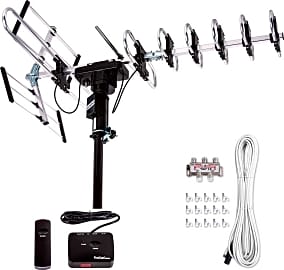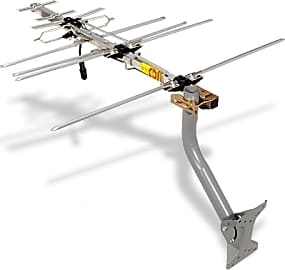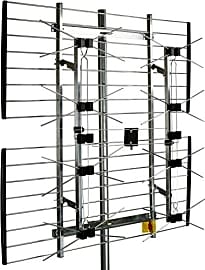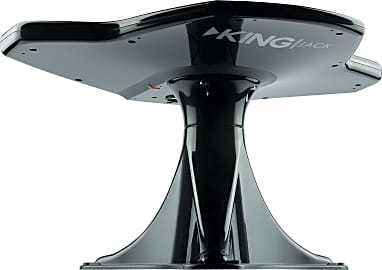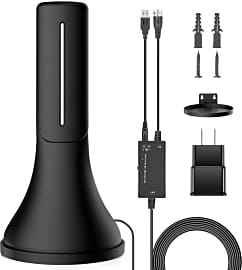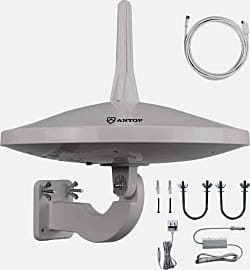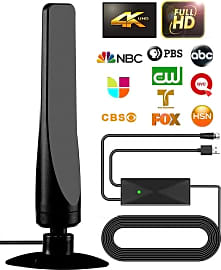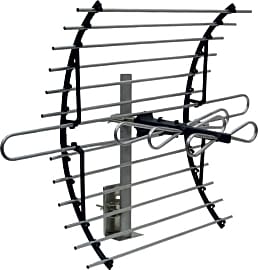The 10 Best TV Antennas

This wiki has been updated 41 times since it was first published in March of 2015. Cutting the cord has never been more popular, thanks, in part, to the great quality of digital, over-the-air television broadcasts. After all, why should you pay for content that is being beamed to your home at no charge? With the right one of these antennas, you will have access to dozens of VHF and UHF channels on your old analog, or modern, high-definition digital television. When users buy our independently chosen editorial recommendations, we may earn commissions to help fund the Wiki.
Editor's Notes
December 22, 2020:
Antennas have shrunken in recent years, as, in line with the advent of digital TV’s, more channels have moved over from the VHF band to the UHF frequency band. UHF signals are higher frequency (shorter wavelength), which means that components in antennas have become smaller to match and therefore pick up the length of the recently-emerged plethora of shorter UHF wavelengths. While many countries have passed mandates requiring all channels transmit on the UHF band, some local channels in rural areas in the US still use the VHF band, which is why you’re probably best off getting an antenna that’s optimized for both UHF and VHF signals – a clue is to look for something with a variety of rod sizes like the Channel Master CM-4228HD or RCA Yagi - or using two separate antennas, depending on what you want to watch.
In any case, an outdoor antenna will always be a better option where possible, and an indoor antenna may only perform well in relatively urbanized areas. If you are going for an indoor model, then look for something that affords you flexibility to move like the Antier Indoor or Mexonga Indoor I’ve added, and not the leaf-type antennas which aren’t really the best. Do also note that the term ‘HDTV antenna’ is largely a misnomer and marketing tactic, as all antennae receive the same signals, though a digital TV will use an analog-to-digital converter to view those same signals, and will also be able to display them in higher fidelity.
October 09, 2019:
On this update, we attempted to strike the right balance between price and functionality. You might notice, for example, that the pricey Free Signal Marathon is only ranked at #8, despite its popularity and general reputation as one of the best units available. What we concluded, though, is that most of our audience is looking to buy a TV antenna so that they can stop paying a monthly fee for their content. In other words, it's matter of cost. So while the Free Signal Marathon may be a great choice for somebody who is willing to spend a bit extra to maximize the number and quality of channels they receive, in most cases, its cost is simply too high to justify the purchase.
For that reason, we really love the Antennas Direct ClearStream, our #1 pick. It's sold in four different sizes, each one offering a different reception radius. With the strongest one currently being quite reasonably priced, we believe that this, in conjunction with its performance and its lifetime warranty, justifies its place at the top of our list.
Those buying an antenna for an RV have their surest bet in the King Jack Directional (#5), which is this update's addition to this list. If this one doesn't tickle your fancy, check out the Antop UFO (#9).
The other models we've included range from minimalist models like the Mohu Curve 50 (#10) and the Antop Paper Thin (#4), to more elaborate antennas like the Channel Master CM-4228HD at #2. If you're merely looking to supplement your digital streaming subscriptions with some local channels, the minimalist options are pretty good bets.
Unscrambling The Signal
When analog broadcasting evolved into digital broadcasting, so too did the indoor antenna from its traditional rabbit ear counterparts to a flat, square-shaped, thin antenna.
It is no secret, cable and satellite television can be expensive. The next time you get your cable or satellite bill, take a look at all those fees, taxes, and channel bundles your company has forced you to maintain. Does that make the dish or cable box a bad thing? Of course not, but you may find that you'd like to keep things simple while maintaining access to the major networks, without having to pay absurd amounts of money to your provider each month. For that reason, why not go back to basics with a television antenna?
Also referred to as a television aerial, a television antenna is an antenna specifically designed for the reception of over-the-air broadcast television signals. These signals are typically transmitted in a frequency range between forty-one and two hundred fifty megahertz in the very high frequency (VHF) band, which is still currently used for digital television. In order for a television antenna to accommodate such a frequency range, it must be equipped with conductor elements of varying lengths. The length of an antenna's conductors corresponds to the wavelengths the antenna is capable of receiving. Conductors are usually half the wavelength of their intended signals.
Television antennas are created for either indoor or outdoor use. Indoor antennas are usually placed in close proximity to your television set, while outdoor antennas are mounted on a mast outside the home on the roof for the best reception. Dipole and loop antennas are the most common types of indoor antennas.
The dipole antenna is immediately recognizable when we talk about rabbit ears, which always seem to need adjusting. The loop antenna is so named due to its construction of looped wire or tubing with its ends connected to a balanced transmission line. The balanced transmission line may sound complicated, but it's simply a specialized cable used for carrying and distributing cable television signals.
With respect to the outdoor television antenna and its placement atop your roof, the higher it can be installed, the better off you'll be if you live in valleys or among other tall structures that may interfere with the integrity of the television signal itself. However, there is still a potential trade-off, given that a high-placed antenna is difficult to reach when it needs servicing. There is also a vulnerability to bad weather conditions.
When analog broadcasting evolved into digital broadcasting, so too did the indoor antenna from its traditional rabbit ear counterparts to a flat, square-shaped, thin antenna. The evolution of this modern television antenna eliminated the need for constant manipulation and adjusting when trying to enjoy programming. Modern indoor antennas now rival the quality of many outdoor and attic antennas.
Finding The Best Reception
Achieving the appropriate balance between directional capabilities and your environment are two important factors to consider when investing in a television antenna. For example, multidirectional television antennas will work well for you if your transmission towers aren't centrally located, if you want to be able to pick up signals from other cities, and if you live in a rural area with a lot of foliage that interferes with your signal quality. When considering such an antenna, one must also be sure to purchase it with sturdy, all-weather mounting hardware.
By contrast, if you live in a city apartment and are relatively close to your transmission towers, then a flat indoor antenna may be all that you need.
By contrast, if you live in a city apartment and are relatively close to your transmission towers, then a flat indoor antenna may be all that you need.
If a high-definition signal is important to you, many antennas allow you to pick up local high-definition signals for a fraction of the cost of maintaining your cable service or satellite dish.
Some indoor antennas are also optimized for supporting surround sound and even feature USB power supplies for maximizing your home's energy efficiency when the television is turned off.
A Brief History Of Television Antennas
The birth of television antennas dates back to the time of German physicist Heinrich Hertz, who was the first to prove the existence of electromagnetic waves by testing James Clerk Maxwell's electromagnetic theory of light. The theory predicts that electromagnetic waves move at the speed of light, and that light itself is also a type of wave. By 1887, Hertz developed an apparatus for generating and detecting radio waves. He also developed his first radio transmitter around that same time by using an induction coil-driven spark gap and a pair of one-meter copper wires to act as a radiator.
He also developed his first radio transmitter around that same time by using an induction coil-driven spark gap and a pair of one-meter copper wires to act as a radiator.
Hertz placed capacity spheres at either end of the wires for adjusting resonance. He then discovered that when an induction coil applied a high voltage between the two sides, the resulting sparks across the spark gap would generate radio frequency currents in the copper wires. These wires would then release radio waves at very high frequencies similar to those found in modern television transmitters. This transmitter was a precursor to the dipole antenna.
Credited as being the catalyst for one of the biggest television booms in history, the first practical dipole antenna was invented in 1953 by Marvin P. Middlemark. This invention revolutionized the television signal and how it was watched. While the dipole antenna is still in use today, the popularity of high-definition signals has created a niche for high-definition antennas with flat screen televisions that have built-in digital tuners.


